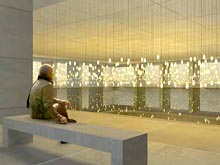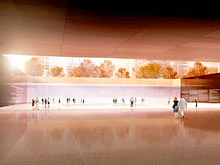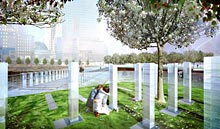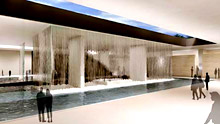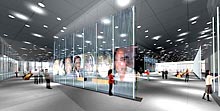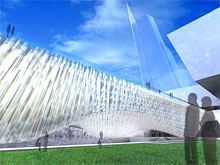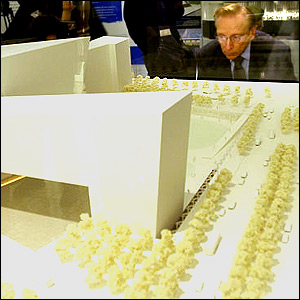
Lyndon Harris was the priest in charge of St. Paul's Chapel when the World Trade Center was destroyed just a few yards away. His experience at Ground Zero, though, was not only one of loss. Now, more than two years later, he smiles as he recalls cooking hamburgers for rescue workers outside the church in the days after September 11. As the rescue effort continued, he said, more and more firefighters came to eat from his grill: "By the end of it, we were a four-star place."
That is why Father Harris had to admit last week that, while he was "just beginning to digest" the eight designs chosen as finalists in the competition for a 9/11 memorial at Ground Zero, he already felt somewhat disappointed that the designs don't reflect his own experience.
"They have a mood, a kind of a vibe, akin to a crypt," he said. "But they are not inspiring."
Father Harris was saying this a day after the designs were presented, as he sat in a small, windowless classroom at Pace University with about a dozen other participants in the latest series of workshops organized by Imagine New York to allow the public to respond. Within days, hundreds of New Yorkers had attended their workshops, and some 10,000 people had made comments on their web site. By early December, the group will submit a short report to the Lower Manhattan Development Corporation, summarizing what it has heard.
It is surely too soon to proclaim a consensus, as many people are still feeling out what they think. But the group with Father Harris -- among them, family members of some who died on 9/11, Ground Zero rescue workers, and people whose designs were among the 5,193 not selected in the final eight -- had some strong reactions.
They talked about what they liked about the designs: All eight recognized each individual victim, provided a contemplative space away from the city, and made creative use of light. And they talked about what they didn't like: The final designs were too "corporate," too "architectural," they had too many "bells and whistles," they lacked a certain humanity.
This is not the first time the public has reacted strongly to plans for Ground Zero, of course. When the Lower Manhattan Development Corporation presented six plans for the site as a whole on July 16, 2002 -- all of them with titles that began with the word memorial (Memorial Square, Memorial Plaza, Memorial Promenade, etc.) -- they were overwhelmingly condemned by the public. Officials bowed to public opinion and held a new competition. On December 18th, nine new plans were presented, the public responded much more favorably, and on February 27th, the Lower Manhattan Development Corporation and Port Authority officials selected the plan designed by Daniel Libeskind.
While Libeskind's overall design for the World Trade Center's replacement suggested where the memorial would go, there was a separate competition for the design of that memorial, which began last August. It included a public hearing, the drawing up of a mission statement, the selection of a "jury" of 13, and then an open competition that, officials say, was the largest of its kind in history.
After some five months of sifting and sorting through the 5,201 entries and deliberating in absolute secrecy, the jury selected the eight that were presented to the public on November 19th. It didn't take months, but more like minutes, for New Yorkers to begin to respond, including those in Father Harris' group at the Imagine New York workshop.
"There was a feeling that there was a huge potential," said Nikki Stern, who lost her husband on 9/11, summing up the views of the group, "but somehow something missed the mark."
DESIGN HIGHLIGHTS: LIGHT AND WATER
The 5,201 design entered the competition were bound by several guidelines:
- to acknowledge each individual who died, including all those who aided in rescue, recovery, and healing
- to create a space for reflection and contemplation
- to acknowledge the historical significance of 9/11 and encourage people to learn more
- to evolve over time
Besides their common goal to reflect these guidelines, the eight finalists also resemble one another in the use of two key elements - light and water.
LIGHT
When Kevin Rampe of the Lower Manhattan Development Corporation introduced the eight chosen designs on Wednesday morning, he characterized them as the next stage in a process that began on September 11, 2001 with the first makeshift memorials -- the flowers, the first heartfelt messages tacked to traffic poles and bus shelters, "the first candles lit at Union Square Park."
Light was also the dominant element in the temporary memorial called the Tribute in Light, two beams of light shining up from Ground Zero every night for a month.
So it is perhaps not surprising that light plays a major role in many of the eight finalists. Three of them use the word "light" in their titles.
In Garden of Lights, natural light comes through holes in the ceiling of underground chambers to create 2,982 individual beams of light shining on 2,982 altars, one for each of the victims.
Inversion of Light includes a space on the northern footprint containing a representation of the floor plan of the towers, lit from underneath. A pool covers the southern footprint, with light shining from below the water. During cold weather, the vapor created by the heat from the light will appear as flames on the surface of the water.
Passages of Light also uses the sun to light a sunken area, through a glass canopy that covers a large part of the memorial site. Beams of light also extend upwards from the floor of this area, creating the effect of a "cloud" of light.
Votives in Suspension creates a room on each of the footprints, dimly lit by hanging candles, one for each of the victims. The candles are suspended over shallow pools at different heights indicating the relative ages of the victims.
WATER
Water is a major element in many recent memorials. The 9/11 memorial at the Pentagon creates small pools beneath the lighted benches that represent the victims. The Oklahoma City memorial contains a shallow reflecting pool of moving water, which is intended to be a place of quiet reflection. Many of the eight memorials for Ground Zero incorporate similar ideas.
Suspending Memory is the plan with the most water, measured by volume. It fills the site with a large pool. The two footprints of the towers act as islands within the pool, connected by a stone and glass bridge. On these tree-shaded islands, there are lighted glass columns, one for each victim.
Reflecting Absence is almost this plan in reverse. A plaza covers the site, with two sunken pools standing where the towers once stood. Around the perimeter of the pools are underground chambers with glass walls.
Lower Waters and Dual Memory also use both light and water, but in a more complex manner than the other six designs.
In Lower Waters, sheets of water fall from a pool on top of a granite building on the northern footprint. Across a slanted park which covers the entire site, an open plaza on the southern footprint has a wall listing the names of the victims, trees, benches, and the facade of a 9/11 museum.
In a semi-enclosed area on the northern footprint, Dual Memory sends falling water down sheets of glass on which there are portraits of the victims. On the roof of this area are 2,982 spots of light, one for each victim. Ninety-two sugar maple trees planted in a lowered plaza on the southern footprint represent each of the countries that lost a citizen on 9/11.
THE NAMES, THE BEDROCK
All eight designs list all 2,982 names. For some of the firefighters who attended the unveiling ceremony at the Winter Garden on Wednesday, one question took priority: How were the names listed?
"We want to make sure that the firemen and the police officers that were killed in 9/11 are listed together as a group under the heading of FDNY [with] a description of what they did if they came here to save lives and lost their own,"said Patrick McCarbill, one of several dozen firefighters with the Coalition of Fallen Heroes who attended the ceremony in bunker jackets.
The question of names has been a sensitive one, as some feel strongly that rescue workers should be honored by being listed together with ranks, and others are adamant about avoiding the hierarchy that such an action would create among the victims. As the program for the memorial process did not guide designers on this issue, there were several different approaches.
Two of the designs list rescue workers together. Inversion of Light organizes names into groups of civilians and non-civilians, while Passages of Light groups the names based on where the victims were at the time of their deaths: There is a distinct group of names for those who died in each tower, separated out by civilians and rescue workers.
One more, Suspending Memory, distinguishes firefighters and police officers with a bronze helmet on the glass pillars used to represent the individual victims.
The rest of the designs either avoid the issue altogether (at least for the moment), or list names alphabetically.
But while the Coalition of Fallen Heroes found at least something to approve of in some of the plans, the Coalition of 9/11 Families said that each of the plans deserved a grade of F, because they failed to preserve the footprints of the towers to the bedrock level, a depth of 70 feet. None do because the Libeskind design called for the footprints to descend just 30 feet below street level.
"ARCHITECTURAL FEATS, LACKING IN FEELING"
The competition was open and anonymous, which its organizers said would encourage diversity among its entrants. Indeed, designs came from 49 states and 62 countries foreign countries. But architects dominated the finalist field, a result, say critics, of stringent requirements that kept laypeople from competing effectively. The eight designs very much reflect the background of their authors.
This led many to criticize the designs as overdone, gimmicky, or sterile, impressive as architectural feats but lacking in emotion. Participants in the Imagine New York workshops voiced disapproval that, while the designers invented creative ways to bring new elements in, few did much to highlight the elements already there, or to bring back artifacts that were originally at the site - like the damaged globe currently located at Battery Park.
Form, some observed, seems to have taken precedence over feeling.
Herbert Muschamp, the architecture critic from the New York Times, wrote that most of the designs "offer an excess of spectacle...Everything here is wonderfully polished. Each finalist could be the winner in a dozen memorial competitions. But that is not really a compliment, is it?"
At the same time that the designs were criticized for having too much of an architectural bent, they were accused of lacking sufficient planning perspective to have them become part of lower Manhattan beyond the walls of the memorial site itself.
Justin Davidson wrote in Newsday that the designers want to "build 10-story barriers and buried bunkers, they would flood the site and create islands - anything to carve a massive mausoleum out of a vital city."
"They have light, air, water and greenery," wrote Joyce Purnick in the New York Times. "What the eight designs for the World Trade Center memorial do not have is a feeling of New York."
THE PUBLIC AND THE PROCESS
To some critics, the final memorial designs were bound to be disappointing - not so much because of the designs themselves, says architectural historian Max Page, but because of what he sees as "fundamental flaws in the process" of choosing them. (See Rethink The Type Of Memorial We Want.) To some, one of those flaws was the lack of public participation.
Officials from the Lower Manhattan Development Corporation see it differently. They refer to the future memorial at Ground Zero as the "people's memorial," and regularly champion the amount of public participation that they have built into the kind of design competition that usually takes place entirely away from public scrutiny. In drafting the mission statement for the memorial, the competition's organizers solicited written responses from all those who lost family members on 9/11, held public forums, and consulted with its Family Advisory Council on what requirements to put into the competition.
Since that point, the jury has been operating out of the public eye, and will not be open to an official comment period before a final design is chosen. Indeed, the jury members and the finalists are forbidden from talking to the public, though officials of the Lower Manhattan Development Corporation say the jury will take into account reactions at civic meetings such as the ones held by Imagine New York.
That is the reason why the eight finalists were made public at all, rather than simply waiting to announce the final winning design, according to Rick Bell, head of the New York chapter of the American Institute of Architects "What is a two-stage process if not a chance for public discourse?"
Charles Wolf, a member of the Family Advisory Council, also believes that public opinion will filter back to the jury. But he thinks the jury should be the final arbiters. "Those who are shouting about the fact that they don't like this and they want to have that are a vocal minority. I respect their views, but I don't appreciate the fact that they are trying to preempt the jury process to advance their own views....A republic works better than a democracy in this case because you have a qualified representative to do it for you. The jury is our representative." (See Let The Memorial Jury Do Its Work.)
For the Coalition of 9/11 Families, this is not sufficient. To many of its members, an important element of the memorial has already been eliminated from consideration. The group has responded by looking outside the process for influence. In addition to sponsoring an online petition that calls for historic landmark status for the footprints of the towers, requiring that they be left untouched, the group has worked with Representatives Carolyn Maloney and Chistopher Shays to introduce a bill into Congress which would study whether the spots where the towers stood should be national landmarks.
Phil Craft, a spokesman for Maloney, sees the coalition's activities as a sign of a failure in the process of creating a memorial. "If the families are coming in droves [to complain]," he said, "then the question is, do they have a seat at the table?"
GOING FORWARD
The jury is expected to choose the winning design by January. Until then, the finalists will go into more depth. Funding, not an issue in the first stage, is now being considered, and designers have to draw up a budget for their designs. When the time comes, the project will be paid for through a foundation which is currently being established. Fundraising will begin in January, according to Governor George Pataki. There is also room for compromise and fine-tuning on the physical aspects of each plan.
Lyndon Harris of St. Paul's Chapel is optimistic that the final decision will be handled well, but he is still wary. The process is not over yet and the stakes, he observes, are high.
"Whatever statement we make is going to be read on a global scale," he said. "We have a great opportunity to do something great. We also have a great chance to screw up."
